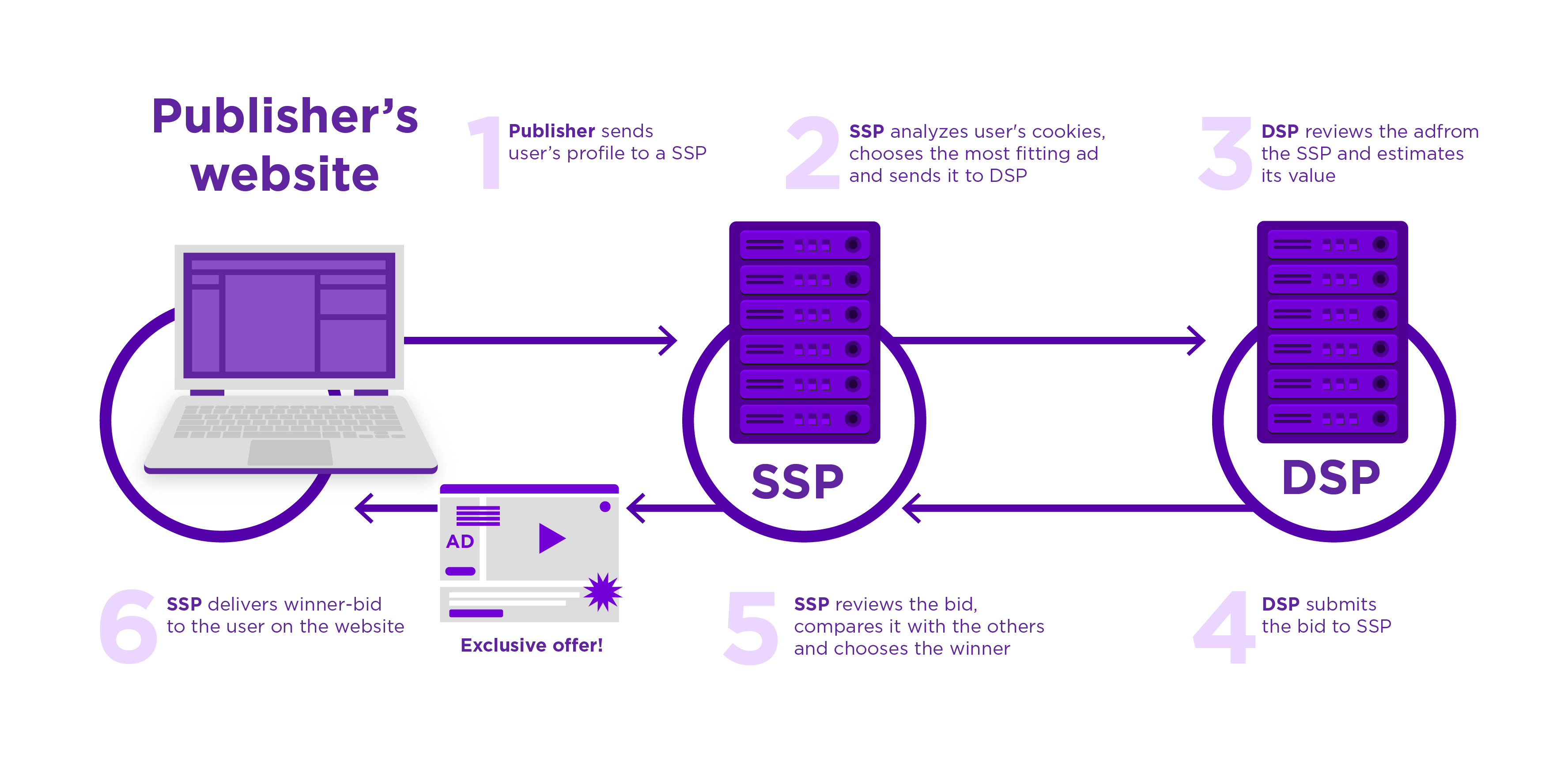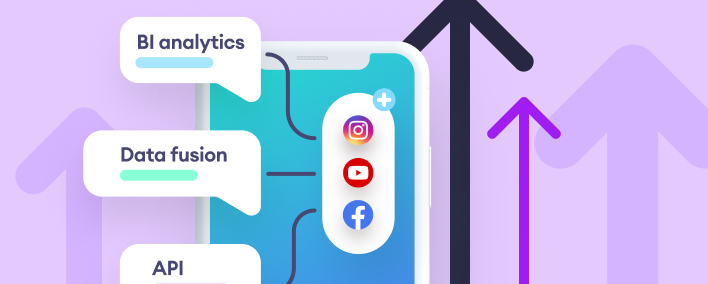With consumers wandering across different devices and mobile apps, looking through various websites, at some point it became very challenging to accommodate targeted ads. Luckily the situation changes with the emergence of programmatic advertising.
To put it simply, programmatic advertising is a technology-enabled process of purchasing and selling advertising in real-time. It presents the automated workflow that minimizes the risk of human error. All traffic exchange operations are happening among different servers. Traffic managers define the campaign parameters, and the ad tags are automatically transmitted to the destination ad server.
The whole programmatic advertising ecosystem is not an easy one, and it takes a bit of patience to understand it. But once you go through all its aspects, you see how it transformed the industry. Allowing that you already understand the principles of its work, you see that before, the advertising sphere didn’t have such an option.
But first things first, to understand the whole programmatic advertising ecosystem, you first need to be acquainted with all key definitions.
Key glossary:
SSP – supply-side platform, a software that is widely used to sell online advertising in an automated fashion.
DSP – a demand-service platform, a tool or software that allows advertisers to buy ad placements automatically.
Publisher – an individual website owner or other business entity that serves the promotional role in affiliate marketing. Publishers earn commissions for referring sales, leads, and traffic to advertisers by placing affiliate marketing display elements such as links and banners on their websites.
Ad tag – a snippet of code that advertisers insert within the HTML code of a webpage where an ad is due to be displayed. Ad tags are used for many purposes, such as determining parameters of every individual ad, providing needed creatives, collecting performance metrics, and generating campaign reports.
Ad server – a technology that enables ads management, display, and tracking on different digital properties, like desktop, mobile, emails, games, etc. It also serves to monitor whether impressions serve their function and whether there is a need to optimize creatives’ performance.
An affiliate network – an intermediary program that connects advertisers and affiliate marketers.
Ad network – is a technology platform that acts as an ad inventory broker between advertisers and publishers. Ad network aggregates numerous ad supplies from publishers and then sells it to advertisers.
Programmatic & Real-time bidding?
In the discussions about programmatic advertising, there is one, the most common puzzlement that nobody can avoid – the confusion around programmatic advertising and real-time bidding. When newbies dive into this topic, the majority ask the same question – is programmatic advertising the same as real-time bidding. Does it differ from RTB at all?
And while they sound very similar and the principal of their work can be described almost in the same words, they are not the same. Or if to be more specific, RTB represents only a part of programmatic advertising. Though we must admit, the share of RTB in programmatic advertising is vast, up to 90% of all programmatic buying.
-Real-time bidding
Programmatic is an informational tool that helps advertisers decide whether they are interested in buying ad space. RTB is one way of acquisition. It is a server-to-server technology that allows buying and selling display impressions while page loads. You can think of RTB as an online auction marketplace for purchasing impressions in actual time, which is, by definition, programmatic.
-Programmatic direct
But advertisers can also use programmatic without utilizing RTB, in which case, they would be dealing with programmatic direct. In comparison with RTB, the programmatic direct is closer in its character to traditional media buying. Under the programmatic direct scheme, advertisers can purchase a guaranteed number of impressions beforehand.
-Private Marketplace
One more type of programmatic advertising is the Private marketplace, PMP, for short. PMP is a form of RTB, with the difference in inventory access. In comparison to the ordinary programmatic advertising, the inventory on PMP is not available for all, only to selected advertisers. And it is mainly reserved for premium websites and well-known brands.
How does programmatic advertising work?
Let’s look at the whole process of programmatic advertising step by step.

First step. It starts once a new user opens a website involved with programmatic advertising — new users’ sessions on-site launch automated bidding to choose the best ad for a specific viewer. At the same time, the publisher’s website analyzes the user’s profile and sends its ad characteristics to a supply-side platform. At the same time, the publisher reserves its product for advertisers to purchase.
Second step. The SSP carefully analyzes all user’s cookies and finds out the best, most fitting ad for a particular user and forwards it to a demand-side platform.
Third step. Exactly at this moment, a DSP steps in. Its role is to review the information from the SSP and estimate the user’s worth to allot its value subsequently.
Fourth step. Once a value is set, it is a bid, that the DSP submits to the SSP.
Fifth step. The SSP reviews the received bid, compares it with other bids, and chooses the winner. Usually, the highest bid wins.
Sixth step. The final one. SSP delivers the winner-bid to a user on the website.
While the description sounds pretty long and complicated, the whole process takes around a second, upon a page load time.
Media-buying transformation
If not programmatic advertising, what are the other options then? Programmatic advertising is an automated process that before technology development was done by humans and had an absolutely different form. Right now, the choice of ad best fitting a particular user is decided in the smallest fraction of a second using ML methods. While it was obviously not possible when managed by humans, it doesn’t mean that it didn’t exist back then. So how was media buying managed in the past?
It used to be manual, and brands used to negotiate contracts with publishers directly establishing numerous contacts. All media buying activities were carried out by traffic managers, mainly using spreadsheets. The whole process looked like a system where agencies had to submit orders, often written ones, straight to publishers, and negotiate price, numbers, and other details. Back then, there were no options on how to handle it, but luckily with the escalation of the technologies, speed and agility in marketing, this process got automated, and now we have programmatic advertising.
But even though programmatic advertising presented promising opportunities, the shift of publishers and advertisers towards programmatic and RTB didn’t happen that fast. The most common concerns were that it might jeopardize the quality of advertising on their site.
In the early stages of development, there were some challenges with ads accidentally appearing on unwanted websites or youtube videos. But with the targeting becoming more granular, it’s no longer a problem. Once more and more advertisers got on board with programmatic and RTB, publishers followed suit and increased their budgets to accommodate this new technology.
Thus, publishers aiming at rapid growth and securing their position in digital advertising should seriously consider programmatic and RTB as a way to sell their ad inventory in real-time. These two technologies will definitely bring them closer to the final goal – a significant increase in ad revenue.

















